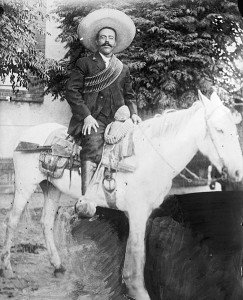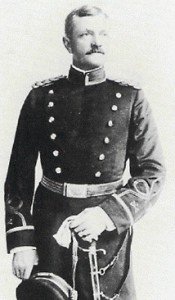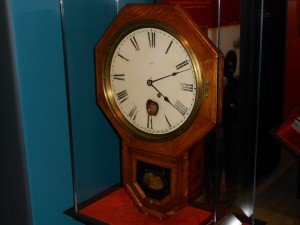
When the United States launched a military expedition against Mexico’s Francisco Poncho Villa on March 14, 1916, the U.S. Army undertook one of the most historic manhunts in all of history. The roots of the expedition grew from the ongoing Mexican Revolution.
Thank you for reading this post, don't forget to subscribe!The match that lit the fire and forced President Woodrow Wilson to order General John Pershing into northern Mexico was the night time invasion of Columbus New Mexico, just north of the Mexican border. The invader was Poncho Villa and his Villistas.
There are two theories among historians for Villa’s invasion into the United States. One reason offered is that the United States appeared, or at least appeared to Villa, to be backing one of his foes. There were many factions during the revolution. The second reason proffered is that Villa had purchased and paid for supplies in Columbus New Mexico and hadn’t received them. Both have their merits but the first reason seems more probable. There is even another more probable reason explained later in this story.
As to what Poncho and his troops hoped to achieve with the invasion is more murky. If he was looking for attention, he certainly got it. Pershing’s orders were reportedly to catch Poncho Villa dead or alive and to make certain no further incursion on American soil would take place.
The Chain of Events
The trouble in Mexico began in 1913 when General Huerta seized the reins of the Mexican government. The United States refused to recognize the new government and ceased to have any diplomatic relations with Mexico. At the same time John Pershing returned to the U.S. from the Phillepines in December of 1913 and was ordered to report to the San Francisco brigade. At the time this was due to the increasing hostilities with the new Mexican army dictator. For whatever reason, the San Francisco brigade was designated as the first to be up in combat. Tragedy struck when Pershing’s wife and three daughters died in a fire at the Presidio in San Francisco. Only Pershing’s son survived. He and his son then moved to Fort Bliss Texas where Pershing was commanding officer.
On March 9, 1916, five hundred of Poncho Villa’s troops including three of his officers invaded the U.S. border town of Columbus NM. New Mexico history would forever change. At the time, the 13th U.S. Cavalry regiment was camped at Columbus. Villa’s troops raided the village in the middle of the night. The village was attacked by surprise. It didn’t take long for the U.S. to react. On March 14, 1916, Brigadier General John J. Pershing, on orders from President Woodrow Wilson, was sent into Mexico with what would eventually be a 10,000 man force with orders to capture Poncho Villa dead or alive.
The biggest problem Pershing faced at the start was a lack of adequate supplies. Some historians found this a shock since relations between the U.S. and Mexico had been on a downtrend for a few years and certainly adequate supplies should have been placed near the border with Mexico in case of trouble. The possibility of hostile action had been on the table since 1913. For General Pershing, the supply situation was critical since his troops penetrated some 300 miles into Mexico in search of Villa.
A Unique Conflict

On a historical note, this expedition was the first to introduce an aircraft into a combat zone. During this expedition, anything immediately south of the Mexican border was a combat zone. The aircraft flown was a Curtiss Jenny. Jenny stood for the JN designation that Curtiss used for the first series of aircraft produced. Eight Curtiss JN-3 aircraft were deployed to Pershing’s Mexican campaign during 1916-17 with most being used for observation. The JN-3’s were newly produced aircraft taking the place of the discontinued JN-2″s.
To give you an idea of how military campaigns changed at the turn of the century, the Curtiss Jenny deployments to Mexico occurred forty years after George Armstrong Custer’s defeat at the Battle of the Little Bighorn. Another first when it came to military expeditions was the media involvement. The media during the last half of the 1800’s regularly accompanied army expeditions in the west. Most were reporters from eastern newspapers and magazines. Some were from the midwest used as stringers for the eastern press. In fact, one reporter lost his life during Custer’s defeat. Technology changed a lot from about 1890 to 1916.
The use of the Curtiss Jenny during the Mexican campaign was not the only first. The attack on Columbus New Mexico was the first time that a U.S. settlement in North America was attacked by a foreign force. Another unique element regarding the reporting of the Pershing’s expedition was the use of film footage. Never before had that been done and this type of video would also chronicle much of World War One which was only a few years later. Pictures of Poncho Villa were printed all over the U.S. Yet, another first in the Mexican Expedition was the use of three Dodge armored cars by the U.S. The armored attack was led by then Lt. George Patton.
Historians will notice that there were conspiracy theorists opining about why the U.S. went to war with Mexico. Pershing’s expedition was really not a war with Mexico. It was designated officially as a punitive action targeted against Poncho Villa and his troops. Villa had been a Mexican officer in the northern part of Mexico and was a faction among several during the Mexican Revolution. I have read accounts where some have speculated that it was an action by the U.S. government to help prepare their troops for possible deployment to the conflicts brewing in Europe. I think that is highly doubtful. The battles in Mexico while Pershing’s troops were searching for Poncho Villa would hardly be a dress rehearsal for what was to come in Europe.
The conflicts in Mexico were essentially hit and run episodes with no defined fronts. What is a much more plausible theory, although not entirely proven, was that Villa raided into the United States at the urging of Germany which wanted to keep the U.S. occupied on their own soil thus keeping them out of the European conflict. There are books written about an intercepted cable from Germany to Mexico implying such a scenario.
See our Trips Into History articles on the links below…
The Paul Revere House in Boston MA
Crossing the Atlantic With Marconi’s Wireless
Engagements During the Mexican Expedition

General John J. Pershing and his troops never were successful in flushing out Poncho Villa. There were several conflicts with Villistas in northern Mexico. The first confrontation occurred on March 29, 1916 near the town of Guerrero. The U.S. force of 375 men killed seventy-five of Villa’s troops with no fatalities to the Americans. The second engagement was on April 12, 1916 when the American troops were outnumbered some five to one. The Americans were able to retreat to a nearby village. It was reported that two Americans were killed along with more than a dozen Villista losses. Another was a skirmish on April 22nd between the Villistas and members of the U.S. Seventh Cavalry. Killed were two Americans with estimates of over thirty Villista killed. The fight broke off at sunset.
The clock shown above is on display at the New Mexico History Museum. This clock has a bullet hole as a result of the Villista invasion of Columbus New Mexico.
Two other towns in the United States came under attack during the Mexican Expedition. The towns of Glen Springs and Boquillas Texas were attacked by Villia”s men while the U.S. Eleventh Cavalry was engaged in another battle nearby, the Mexicans won a small battle at Glen Springs against a squad of nine Fourteenth Cavalry soldiers and at Boquillas they ransacked the town and took two captives. Again, it’s hard to determine what these small raids on Texas border towns would accomplish.

The revolver pictured at right is on display at the New Mexico History Museum. This revolver was recovered after the villista raid on Columbus New Mexico. The revolver was originally shipped to the Mexican Army but somehow ended up with the Villistas.
The last battle during the Mexican Expedition occurred on June 22, 1916 between the U.S. Seventh Cavalry along with the African-American Tenth Cavalry against troops from the new president Carranza of Mexico. Both sides suffered losses with over 40 U.S. troops taken captive.There were eleven U.S. losses and 24 Mexicans killed and about 40 wounded. The Mexican troops retreated to the town of Chihuahua. Pershing wanted to go after the Chihuahua garrison and was denied approval from President Wilson. Wilson feared that another battle against Carranza’s troops would ignite a full scale war.
The Results of the Expedition
As mentioned above, the United States never was able to capture Poncho Villa. During the campaign, the U.S. troops were able to kill two of Villa’s generals and about 160 of his men. Poncho Villa was never able to cob together another fighting force after the U.S. departure from Mexico in January of 1917. Pershing believed that the expedition was a success but privately blames President Woodrow Wilson for putting too many restrictions on how he and his forces would operate within Mexico. In other words, political considerations from Washington tied his hands. He was probably correct.
As for General John J. “Black Jack” Pershing, he would go on in a very short time to lead the American Expeditionary Forces in World War One. As for Poncho Villa, he would become a Mexican folk hero to some but his influence was on the decline. He was given a considerable amount of acreage at his retirement. Many of his loyal troops stayed along on Villa’s hacienda and some served as personal bodyguards. Poncho Villa and two of his bodyguards were killed by a group of riflemen on July 20, 1923 in the town of Parral Mexico. There were two basic theories about Villa’s assassination. The first was that it was revenge from the family of one of Villa’s generals who was killed during the conflict with the U.S. The other theory is that Villa was killed for political reasons after he reportedly boasted about running for president of Mexico. The exact reason I’m sure will never be known for certain. The action of the Pershing Expedition and the attack on Columbus New Mexico by the troops of Poncho Villa will always be a fascinating part of North American history.
(Article copyright Trips Into History. Photos of Poncho Villa and John J. Pershing are from the public domain. Photos of Columbus New Mexico clock and Villista revolver are from author’s private collection)
